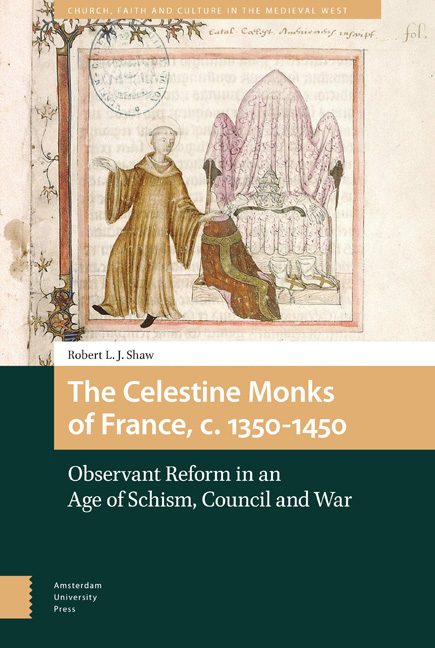Book contents
- Frontmatter
- Contents
- Maps and Figures
- Abbreviations
- Acknowledgements
- Introduction: The Celestine monks of France and the rise of ‘Observant’ reform
- Part I The French Celestines in their world
- Part II The world of the French Celestines
- Epilogue and conclusion
- Appendix 1 Lists and map
- Appendix 2 Reductions of foundation Masses (beyond anniversary Masses) at the Celestine monastery of Paris, 1414 and 1436
- Appendix 3 Reduction of foundation Masses (beyond anniversary masses) at the Celestine monastery of Sens, 1414
- Index
4 - Foundations, benefactions and material maintenance
Published online by Cambridge University Press: 16 February 2021
- Frontmatter
- Contents
- Maps and Figures
- Abbreviations
- Acknowledgements
- Introduction: The Celestine monks of France and the rise of ‘Observant’ reform
- Part I The French Celestines in their world
- Part II The world of the French Celestines
- Epilogue and conclusion
- Appendix 1 Lists and map
- Appendix 2 Reductions of foundation Masses (beyond anniversary Masses) at the Celestine monastery of Paris, 1414 and 1436
- Appendix 3 Reduction of foundation Masses (beyond anniversary masses) at the Celestine monastery of Sens, 1414
- Index
Summary
Whatever else may be said about the state of late medieval coenobitic monasticism in the West, it would be impossible to claim that the period under study was particularly generous to monasteries on a material level. The tales of financial diminution, of the collapse or secularization of houses struggling for funds, seem certainly to far outweigh those of expansion and new foundations. Such was not the case with the Celestines. Theirs is unquestionably a story of growth: between 1300 and 1450 seventeen monasteries were built for them, thirteen of them in the period directly under study. Their expansion can appear somewhat exceptional, however; in their region, only the Carthusians and the Colettine Claresses seem to have achieved comparable feats. Overall, moreover, there is a striking contrast with the monastic expansions of the early and high Middle Ages that saw hundreds upon hundreds of Benedictine and Cistercian houses built, and after them, a similar wave of mendicant growth. The financial instability of existing houses has often been understood from perspectives that take into account wider macro- and microeconomic trends. The Black Death and its recurrences took a particularly heavy toll on monasteries, both in terms of their own numbers and on their finances, the ongoing effects of depopulation hurting landed incomes. In France, meanwhile, the Hundred Years War caused damage to monastic property and population displacements that likewise destabilized communities. Nevertheless, the fact that late medieval reformers could not find a way to expand in new houses in the manner of previous generations might seem to suggest the declining prestige and social relevance that has sometimes been alleged of vowed religious life, and of coenobitic monasticism in particular, in the late Middle Ages.
And yet, Observant monastic reform was an explosion of the sort that surely required significant outside interest. In the case of the French Celestines, their founders and major benefactors represent a ‘Who's Who’ of late medieval France: the Valois monarchy, Louis, duke of Orleans, the Avignon papacy and so on. Moreover, these monks were drawn very close to the society that bestowed these gifts on a spatial level. As this chapter will make clear, their supporters were not only found within the highest echelons, but drawn from a spectrum that ran down to the mid-tier of society; it was not without breadth.
- Type
- Chapter
- Information
- The Celestine Monks of France, c. 1350–1450Observant Reform in an Age of Schism, Council and War, pp. 165 - 210Publisher: Amsterdam University PressPrint publication year: 2018

